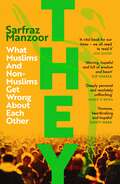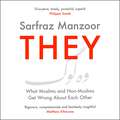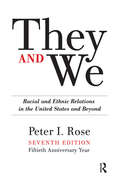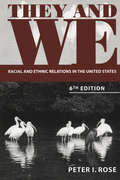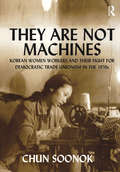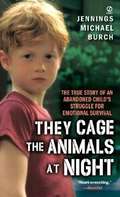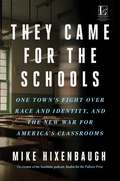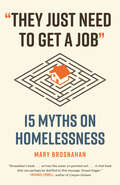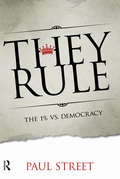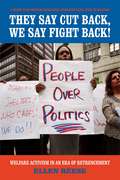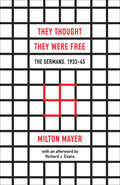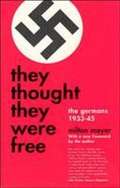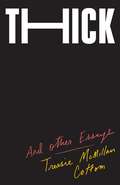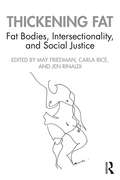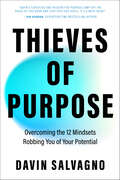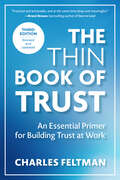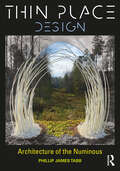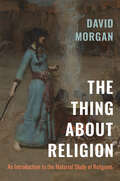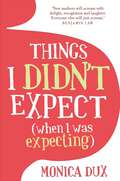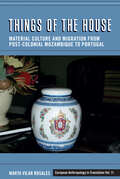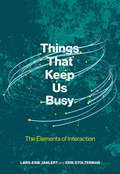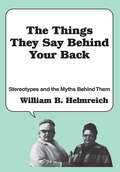- Table View
- List View
They: What Muslims and Non-Muslims Get Wrong About Each Other
by Sarfraz ManzoorA powerful and deeply personal exploration of a divided country - and a hopeful vision for change.'This is not another book about the relationship between Muslims and non-Muslims. It is THE book. . . . Absolutely not to be missed.' - Matthew d'AnconaSarfraz Manzoor grew up in a working-class Pakistani Muslim family in Luton - where he was raised to believe that they were different, they had an alien culture and they would never accept him. They were white people.In today's deeply divided Britain we are often told they are different, they have a different culture and values and they will never accept this country. This time they are Muslims.Weaving together history, reportage and memoir, Sarfraz Manzoor journeys around Britain in search of the roots of this division - from the fear that Islam promotes violence, to the suspicion that Muslims wish to live segregated lives, to the belief that Islam is fundamentally misogynistic. THEY is also Manzoor's search for a more positive future. We hear stories from Islamic history of a faith more tolerant and progressive than commonly assumed, and stories of hope from across the country which show how we might bridge the chasm of mutual mistrust. THEY is at once fiercely urgent, resolutely hopeful and profoundly personal. It is the story of modern, Muslim Britain as it has never been told.'Humane, heart breaking and hopeful' - Kirsty Wark'Extraordinarily researched and courageously confronting, Sarfraz Manzoor writes with a rare blend of historical depth and personal authenticity. Profoundly personal and refreshingly honest, They tells the urgent and often untold story of Muslim Britain.' - David Lammy MP
They: What Muslims and Non-Muslims Get Wrong About Each Other
by Sarfraz ManzoorA powerful and deeply personal exploration of a divided country - and a hopeful vision for change.'This is not another book about the relationship between Muslims and non-Muslims. It is THE book. . . . Absolutely not to be missed.' - Matthew d'AnconaSarfraz Manzoor grew up in a working-class Pakistani Muslim family in Luton - where he was raised to believe that they were different, they had an alien culture and they would never accept him. They were white people.In today's deeply divided Britain we are often told they are different, they have a different culture and values and they will never accept this country. This time they are Muslims.Weaving together history, reportage and memoir, Sarfraz Manzoor journeys around Britain in search of the roots of this division - from the fear that Islam promotes violence, to the suspicion that Muslims wish to live segregated lives, to the belief that Islam is fundamentally misogynistic.THEY is also Manzoor's search for a more positive future. We hear stories from Islamic history of a faith more tolerant and progressive than commonly assumed, and stories of hope from across the country which show how we might bridge the chasm of mutual mistrust.THEY is at once fiercely urgent, resolutely hopeful and profoundly personal. It is the story of modern, Muslim Britain as it has never been told.'Humane, heart breaking and hopeful' - Kirsty Wark'Extraordinarily researched and courageously confronting, Sarfraz Manzoor writes with a rare blend of historical depth and personal authenticity. Profoundly personal and refreshingly honest, They tells the urgent and often untold story of Muslim Britain.' - David Lammy MP(P) 2021 Headline Publishing Group Limited
They and We: Racial and Ethnic Relations in the United States-And Beyond
by Peter I. RoseThe first edition of They and We appeared shortly after the March on Washington, where Martin Luther King Jr. gave his memorable "I Have a Dream" speech. It was published just before the Voting Rights Act of 1965 was passed by Congress. The book, read by tens of thousands, has been updated and expanded five times, each edition maintaining the original intention of the author to provide grounding in the sociological study of inter-group relations: examining prejudice, discrimination, minority status and other core concepts in straightforward, jargon-free prose, as well as tracking social, economic, political and legal developments. The new, 7th (50th anniversary) edition of They and We continues the tradition, depicting recent demographic changes and persisting patterns (such as the 'leapfrog' phenomenon, where, as in the past, many African-Americans are left behind as newer groups move in, up, and over). It also covers new developments, including the rise of Islamophobia in the wake of 9/11. An entirely new chapter compares perspectives in the United States with situations overseas, particularly with regard to nativist and nationalist movements and the rise of xenophobia in this society and in many others.
They and We: Racial and Ethnic Relations in the United States
by Peter I. RoseSince its release shortly after the famous March on Washington in 1963, They and We has been a leading text in the field of racial and ethnic relations in the United States. The tradition continues. They and We, 6th edition, presented in the form of twelve linked essays plus an epilogue, offers a jargon-free introduction to the critical study of America's people, their origins and encounters. In addition to a four chapter section devoted to the social history of our diverse population, the author examines the roots of prejudice, patterns of discrimination, the meaning of "minority status," and the issues of power, politics, and pluralism. Particular attention is paid to continuing struggles for group rights among those most beleaguered, reactions to the dramatic increases in immigration from Asia and Latin America and the resurgence of nativism among those who once again feel threatened by "alien" forces, recent political crises such as occurred in the aftermath of the attack on the World Trade Towers and the Pentagon on September 11, 2001, and the war and occupation in Iraq, and continuing debates over multiculturalism. Every chapter has been updated and, where appropriate, changed or added to in light of new challenges and new perspectives. Those familiar with this sociological classic will be pleased to note that Peter Rose's approach to this subject continues to be grounded in his sensitive and engaging approach to the consideration and assessment of troubling issues. Others will come to appreciate this orientation. And all will benefit from the explication of key concepts, the clarity of exposition, and the comprehensiveness of coverage - from the observations of the French visitor Alexis de Tocqueville to contemporary Critical Race Theorists -- in what is still a rather small book.
They Are Not Machines: Korean Women Workers and their Fight for Democratic Trade Unionism in the 1970s
by Chun SoonokThe multi-faceted tensions created in developing countries between a burgeoning popular desire for democracy and the harsh imperatives of modernisation and industrialisation are nowhere more evident than in the so-called 'Asian tiger' nations. Of all those nascent economies, South Korea in the 1960s and 1970s stands pre-eminent for the magnitude and speed of its development and the extraordinarily oppressive and inhumane conditions that its labour force, mainly women and young girls, were compelled to endure. The author of this book was one of those young girls who suffered in the warren of sweat-shop garment factories in the slums of central Seoul. With little or no support from male co-workers, and despite their political naivety and the traditionally subordinate status of Korean females, the women textile and garment workers confronted the ruling authority at all levels. The author's mother was one of their leaders, and her eldest brother sacrificed his life for their cause. Despite appalling state-directed violence, betrayal by erstwhile colleagues, the chicanery and mendacity of employers' cooperatives and countless other setbacks, these uneducated and overworked women finally succeeded in forming the first fully democratic trade union in the history of Korea. Based on compelling personal accounts this is the first published account of the women's struggle, and it throws much light on the process of modernisation and industrialisation in Korea and beyond.
They Cage the Animals At Night: The True Story of a Child Who Learned to Survive
by Jennings Michael BurchAn autobiography of a boy who learned to reach out for love despite being left in an orphanage and growing up in many foster homes.
They Came for the Schools: One Town's Fight Over Race and Identity, and the New War for America's Classrooms
by Mike HixenbaughNATIONAL BESTSELLERThe urgent, revelatory story of how a school board win for the conservative right in one Texas suburb inspired a Christian nationalist campaign now threatening to undermine public education in America—from an NBC investigative reporter and co-creator of the Peabody Award–winning and Pulitzer Prize finalist Southlake podcast. Award-winning journalist Mike Hixenbaugh delivers the immersive and eye-opening story of Southlake, Texas, a district that seemed to offer everything parents would want for their children—small classes, dedicated teachers, financial resources, a track record of academic success, and school spirit in abundance. All this, until a series of racist incidents became public, a plan to promote inclusiveness was proposed in response—and a coordinated, well-funded conservative backlash erupted, lighting the fire of a national movement on the verge of changing the face of public schools across the country.They Came for the Schools pulls back the curtain on the powerful forces driving this crusade to ban books, rewrite curricula, limit rights for minority and LGBTQ students—and, most importantly, to win what Hixenbaugh’s deeply informed reporting convinces is the holy grail among those seeking to impose biblical values on American society: school privatization, one school board and one legal battle at a time.They Came for the Schools delivers an essential take on Donald Trump and Ron DeSantis, as they demean public schools and teachers and boost the Christian right’s vision. Hixenbaugh brings to light fascinating connections between this political and cultural moment and past fundamentalist campaigns to censor classroom lessons. Finally, They Came for the Schools traces the rise of a new resistance movement led by a diverse coalition of student activists, fed-up educators, and parents who are beginning to win select battles of their own: a blueprint, they hope, for gaining inclusive and civil schools for all.
"They Just Need to Get a Job": 15 Myths on Homelessness (Myths Made in America #10)
by Mary Brosnahan&“Readers will come away infuriated, with a greater understanding of the systemic causes of homelessness, and with more compassion for their homeless neighbors. Essential reading for any community affected by homelessness (which is all of them).&” —Booklist, Starred ReviewFor readers of Andrea Elliott and Matthew Desmond, the former CEO of the Coalition for the Homeless breaks through the highly destructive misinformation surrounding our homeless neighborsConservative think tanks like the Manhattan Institute disseminate anti-homeless myths in the media, legislatures, and the larger culture, claiming that our homeless neighbors cause their own predicament and that the best we can do is manage the problem.Drawing on her deep legal knowledge, policy expertise, and decades of frontline service, Mary Brosnahan cuts through the misinformation to deliver two important messages: that homelessness ultimately stems from a lack of investment in affordable housing; and that the greatest myth of all is that we should have no hope. In fact, the proven solutions are well documented, and the ability to enact them depends on us all.Brosnahan takes a nationwide look from New York to Detroit, Philly to L.A., and from rural areas such as Cumberland County, Pennsylvania to debunk 15 widespread misconceptions, including:that the problem is inevitable (in fact, Housing First approaches have shown great success)that &“handouts&” cause homelessness (in fact, the primary causes are flat wages and high rent)that homeless people need to prove that they&’re &“ready&” to receive aid (in fact, enforcing hurdles is far more expensive and less effective than Housing First).With brilliant insight, Brosnahan showcases how by dispelling these pervasive myths rooted in fear, we can embrace the affordable, housing-based solutions that will bring our impoverished neighbors home.
They Rule: The 1% vs. Democracy
by Paul StreetThey Rule reflects on key political questions raised by the Occupy movement, showing how similar questions have been raised by previous generations of radical activists: who really owns and rules the US? Does it matter that the nation is divided by stark class disparities and a concentration of wealth in the hands of a few? Along the way, this book sharpens readers' sense of who the US oligarchy are, including how their fortunes have changed over the course of US history, how they live and think and how to detect and de-cloak them. They Rule is a masterful historical and political analysis, revealing what lies beneath the surface of US society and what ordinary people can do to bring about social change.
They Say Cutback, We Say Fight Back!: Welfare Activism in an Era of Retrenchment
by Ellen ReeseIn 1996, President Bill Clinton hailed the “end of welfare as we know it” when he signed the Personal Responsibility and Work Opportunity Act. The law effectively transformed the nation’s welfare system from an entitlement to a work-based one, instituting new time limits on welfare payments and restrictions on public assistance for legal immigrants. In They Say Cutback, We Say Fight Back, Ellen Reese offers a timely review of welfare reform and its controversial design, now sorely tested in the aftermath of the Great Recession. The book also chronicles the largely untold story of a new grassroots coalition that opposed the law and continues to challenge and reshape its legacy. While most accounts of welfare policy highlight themes of race, class and gender, They Say Cutback examines how welfare recipients and their allies contested welfare reform from the bottom-up. Using in-depth case studies of campaigns in Wisconsin and California, Reese argues that a crucial phase in policymaking unfolded after the bill’s passage. As counties and states set out to redesign their welfare programs, activists scored significant victories by lobbying officials at different levels of American government through media outreach, protests and organizing. Such efforts tended to enjoy more success when based on broad coalitions that cut across race and class, drawing together a shifting alliance of immigrants, public sector unions, feminists, and the poor. The book tracks the tensions and strategies of this unwieldy group brought together inadvertently by their opposition to four major aspects of welfare reform: immigrants’ benefits, welfare-to-work policies, privatization of welfare agencies, and child care services. Success in scoring reversals was uneven and subject to local demographic, political and institutional factors. In California, for example, workfare policies created a large and concentrated pool of new workers that public sector unions could organize in campaigns to change policies. In Wisconsin, by contrast, such workers were scattered and largely placed in private sector jobs, leaving unions at a disadvantage. Large Latino and Asian immigrant populations in California successfully lobbied to restore access to public assistance programs, while mobilization in Wisconsin remained more limited. On the other hand, the unionization of child care providers succeeded in Wisconsin – but failed in California – because of contrasting gubernatorial politics. With vivid descriptions of the new players and alliances in each of these campaigns, Reese paints a nuanced and complex portrait of the modern American welfare state. At a time when more than 40 million Americans live in poverty, They Say Cutback offers a sobering assessment of the nation’s safety net. As policymakers confront budget deficits and a new era of austerity, this book provides an authoritative guide for both scholars and activists looking for lessons to direct future efforts to change welfare policy. A Volume in the American Sociological Association's Rose Series in Sociology
They Thought They Were Free: The Germans, 1933–45
by Richard J. Evans Milton Mayer“When this book was first published it received some attention from the critics but none at all from the public. Nazism was finished in the bunker in Berlin and its death warrant signed on the bench at Nuremberg.” That’s Milton Mayer, writing in a foreword to the 1966 edition of They Thought They Were Free. He’s right about the critics: the book was a finalist for the National Book Award in 1956. General readers may have been slower to take notice, but over time they did—what we’ve seen over decades is that any time people, across the political spectrum, start to feel that freedom is threatened, the book experiences a ripple of word-of-mouth interest. And that interest has never been more prominent or potent than what we’ve seen in the past year. Mayer, an American journalist of German descent, traveled to Germany in 1935 in attempt to secure an interview with Hitler. He failed, but what he saw in Berlin chilled him. He quickly determined that Hitler wasn’t the person he needed to talk to after all. Nazism, he realized, truly was a mass movement; he needed to talk with the average German. He found ten, and his discussions with them of Nazism, the rise of the Reich, and mass complicity with evil became the backbone of this book, an indictment of the ordinary German that is all the more powerful for its refusal to let the rest of us pretend that our moment, our society, our country are fundamentally immune. A new foreword to this edition by eminent historian of the Reich Richard J. Evans puts the book in historical and contemporary context. We live in an age of fervid politics and hyperbolic rhetoric. They Thought They Were Free cuts through that, revealing instead the slow, quiet accretions of change, complicity, and abdication of moral authority that quietly mark the rise of evil.
They Thought They Were Free
by Milton Mayer"Among the many books written on Germany after the collapse of Hitler's Thousand Year Reich, this book by Milton Mayer is one of the most readable and most enlightening. "—Hans Kohn, New York Times Book Review "It is a fascinating story and a deeply moving one. And it is a story that should make people pause and think—think not only about the Germans, but also about themselves. "—Ernest S. Pisko, Christian Science Monitor "Writing as a liberal American journalist of German descent and Jewish religious persuasion Mr. Mayer aims—and in the opinion of this reviewer largely succeeds—at scrupulous fairness and unsparing honesty. It is this that gives his book its muscular punch. "—Walter L. Dorn, Saturday Review "Once again the German problem is at the center of our politics. No better, or more humane, or more literate discussion of its underlying nature could be had than in this book. "—August Heckscher, New York Herald Tribune
Thick: And Other Essays
by Tressie McMillan CottomIn eight highly praised treatises on beauty, media, money, and more, Tressie McMillan Cottom—award-winning professor and acclaimed author of Lower Ed—is unapologetically “thick”: deemed “thick where I should have been thin, more where I should have been less,” McMillan Cottom refuses to shy away from blending the personal with the political, from bringing her full self and voice to the fore of her analytical work. Thick “transforms narrative moments into analyses of whiteness, black misogyny, and status-signaling as means of survival for black women” (Los Angeles Review of Books) with “writing that is as deft as it is amusing” (Darnell L. Moore). <p><p> This “transgressive, provocative, and brilliant” (Roxane Gay) collection cements McMillan Cottom’s position as a public thinker capable of shedding new light on what the “personal essay” can do. She turns her chosen form into a showcase for her critical dexterity, investigating everything from Saturday Night Live, LinkedIn, and BBQ Becky to sexual violence, infant mortality, and Trump rallies. <p> Collected in an indispensable volume that speaks to the everywoman and the erudite alike, these unforgettable essays never fail to be “painfully honest and gloriously affirming” and hold “a mirror to your soul and to that of America” (Dorothy Roberts).
Thickening Fat: Fat Bodies, Intersectionality, and Social Justice
by May Friedman Jen Rinaldi Carla RiceThickening Fat: Fat Bodies, Intersectionality, and Social Justice seeks to explore the multiple, variable, and embodied experiences of fat oppression and fat activisms. Moving beyond an analysis of fat oppression as singular, this book will aim to unpack the volatility of fat—the mutability of fat embodiments as they correlate with other embodied subjectivities, and the threshold where fat begins to be reviled, celebrated, or amended. In addition, Thickening Fat explores the full range of intersectional and liminal analyses that push beyond the simple addition of two or more subjectivities, looking instead at the complex alchemy of layered and unstable markers of difference and privilege. Cognizant that the concept of intersectionality has been filled out in a plurality of ways, Thickening Fat poses critical questions around how to render analysis of fatness intersectional and to thicken up intersectionality, where intersectionality is attenuated to the shifting and composite and material dimensions to identity, rather than reduced to an “add difference and stir” approach. The chapters in this collection ask what happens when we operationalize intersectionality in fat scholarship and politics, and we position difference at the centre and start of inquiry.
Thieves of Purpose: Overcoming the 12 Mindsets Robbing You of Your Potential
by Davin SalvagnoDive Deep into Finding Your Purpose! Thieves of Purpose by Davin Salvagno is a transformative guide designed to help readers overcome obstacles and unlock their full potential.Laws of Success. Through this vital self help tool, Salvagno explores the 12 "thieves" that sabotage our potential and happiness, offering real-life examples, stories, and thought-provoking questions to help readers identify and overcome their personal obstacles and strengthen their moral principles. Drawing from psychology, business research, and interviews with successful leaders, Salvagno provides a comprehensive understanding of how these thief words impact our lives.Finding your purpose at any stage in life. This self help tool is a guide to navigate life's challenges and decision points in any critical stage in your life. Readers will uncover limiting thoughts, develop practical strategies, and cultivate resilience to achieve a more purpose-driven and fulfilling life. If you're seeking to find your purpose, improve work-life balance, and cultivate success, Thieves of Purpose is your self help tool to personal growth and happiness.Inside this valuable self help book you&’ll: Unlock your potential and achieve greater happiness and fulfillment Become empowered to take control of your life through chapters offering vital insights and actionable steps Find support for your journey of self-improvement If you liked The One Truth, The Greatness Mindset, or The 7 Habits of Highly Effective People, you&’ll love Thieves of Purpose.
The Thin Book of Trust, Third Edition: An Essential Primer for Building Trust at Work (The\thin Book Ser. #2)
by Charles FeltmanBest-selling author Charles Feltman updates his business classic, The Thin Book of Trust, with new resources and tools to build trust in the post-pandemic world.Feltman's phenomenal bestseller with almost 100,000 copies sold across two editions outlines in a very simple and quick way the art of building trust between people in organizations as a core essential workplace competency.The updated Thin Book of Trust offers a framework that supports trust building as a workplace competency. It is based on the idea that building trust is a competency, a set of skills that can be learned, improved, and practiced. It will help you continuously improve your ability to build and maintain trust with others. It can also help you create and contribute to a high-trust culture at work.The third edition includes a new study guide and a new resource download page.Charles Feltman says: "Whether you lead others, contribute individually, or serve as a coach, consultant, facilitator, HR or OD professional, your ability to generate and sustain strong trust is critical to the success and well-being of your enterprise. It is my hope this new edition serves you well in becoming an exceptional trust-builder."
Thin Description: Ethnography and the African Hebrew Israelites of Jerusalem
by John L. Jackson Jr.The African Hebrew Israelites of Jerusalem are often dismissed as a fringe cult for their beliefs that African Americans are descendants of the ancient Israelites and that veganism leads to immortality. But John L. Jackson questions what "fringe" means in a world where cultural practices of every stripe circulate freely on the Internet. In this poignant and sophisticated examination of the limits of ethnography, the reader is invited into the visionary, sometimes vexing world of the AHIJ. Jackson challenges what Clifford Geertz called the "thick description" of anthropological research through a multidisciplinary investigation of how the AHIJ use media and technology to define their public image in the twenty-first century. Moving far beyond the "modest witness" of nineteenth-century scientific discourse or the "thick descriptions" of twentieth-century anthropology, Jackson insists that Geertzian thickness is an impossibility, especially in a world where the anthropologist's subject is a self-aware subject--one who crafts his own autoethnography while critically consuming the ethnographer's offerings. Thin Description takes as its topic a group situated along the fault lines of several diasporas--African, American, Jewish--and provides an anthropological account of how race, religion, and ethnographic representation must be understood anew in the twenty-first century lest we reenact old mistakes in the study of black humanity.
Thin Place Design: Architecture of the Numinous
by Phillip James TabbWhat makes the places we inhabit extraordinary? Why are some urban spaces more vital and restorative? Wonderful landscapes, inspiring works of architecture and urban design, and the numinous experiences that accompany them have been an integral dimension of our culture. Up-lifting spaces, dramatic use of natural light, harmonic proportional geometry, magical landscapes, historic sites and vital city centers create special, even sacred moments in architecture and planning. This quality of experience is often seen as an aesthetic purpose intended to inspire, ennoble, ensoul and spiritually renew. Architecture and urban spaces, functioning in this way, are considered to be thin places.
The Thin Woman: Feminism, Post-structuralism and the Social Psychology of Anorexia Nervosa (Psychology Press & Routledge Classic Editions)
by Helen MalsonThe First Edition of The Thin Woman, first published in 1998, provides an in-depth discussion of anorexia nervosa from a critical feminist social psychological standpoint. In the original text, the author argues that the notion of 'anorexia' as a medical condition limits our understanding of anorexia and the extent to which we can explore it as a socially and discursively produced problem. The book now has a new introduction that discusses some of the major cultural and academic developments that have occurred since its first publication. In considering our changing cultural landscapes, the introduction goes on to discuss the so-called ‘obesity crisis’; the emergence of post-feminism; the massive global expansion of digital and social media and, most recently, the Covid-19 pandemic. Turning to academic developments, it focuses on the increasing recognition of intersectional feminism and reflects on how intersectional perspectives are now beginning to shape critical feminist research and theory in this field. The new introduction also highlights the significant growth in the last 25 years of critical feminist research on eating disorders, which has brought with it a greater awareness of intersectional theory and a more inclusive agenda; an expansion of research foci; a diversification of methodologies and the emergence of more egalitarian models of research in which those with lived experience of eating disorders are becoming valued research team members who help to shape research aims, designs and processes. Based on original research using historical and contemporary literature on anorexia nervosa and a series of interviews with women who identified as ‘anorexic’, this book offers critical insights into this problem. It is an invaluable read for anyone interested in eating disorders and gender, developments in feminist post-structuralist theory and discourse analytic research in psychology.
The Thing about Religion: An Introduction to the Material Study of Religions
by David MorganCommon views of religion typically focus on the beliefs and meanings derived from revealed scriptures, ideas, and doctrines. David Morgan has led the way in radically broadening that framework to encompass the understanding that religions are fundamentally embodied, material forms of practice. This concise primer shows readers how to study what has come to be termed material religion—the ways religious meaning is enacted in the material world.Material religion includes the things people wear, eat, sing, touch, look at, create, and avoid. It also encompasses the places where religion and the social realities of everyday life, including gender, class, and race, intersect in physical ways. This interdisciplinary approach brings religious studies into conversation with art history, anthropology, and other fields. In the book, Morgan lays out a range of theories, terms, and concepts and shows how they work together to center materiality in the study of religion. Integrating carefully curated visual evidence, Morgan then applies these ideas and methods to case studies across a variety of religious traditions, modeling step-by-step analysis and emphasizing the importance of historical context. The Thing about Religion will be an essential tool for experts and students alike. Two free, downloadable course syllabi created by the author are available online.
Things I Didn't Expect (when I was expecting)
by Monica DuxPregnancy is natural, healthy and fun, right? Sure it is, if you're lucky. For others, it's an adventure in physical discomfort, unachievable ideals, kooky classes and meddling experts. When Monica Dux found herself pregnant with her first child, she was dismayed to find she belonged firmly in the second category. For her, pregnancy could only be described as a medium-level catastrophe. So, three years later and about to birth her second child, Monica went on a quest: to figure out what's really going on when we incubate. Monica explores the aspects of baby-making that we all want to talk about, but which are too embarrassing, unsettling or downright confronting. She also looks at the powerful forces that shape women's experiences of being pregnant in the west, the exploitative industries, and the medical and physical realities behind it all. Along the way, she fends off sadistic maternal health nurses, attempts to expand then contract her vagina, and struggles to keep her baby's placenta off her hippy brother's lunch menu.
The Things of Life: Materiality in Late Soviet Russia
by Alexey GolubevThe Things of Life is a social and cultural history of material objects and spaces during the late socialist era. It traces the biographies of Soviet things, examining how the material world of the late Soviet period influenced Soviet people's gender roles, habitual choices, social trajectories, and imaginary aspirations. Instead of seeing political structures and discursive frameworks as the only mechanisms for shaping Soviet citizens, Alexey Golubev explores how Soviet people used objects and spaces to substantiate their individual and collective selves. In doing so, Golubev rediscovers what helped Soviet citizens make sense of their selves and the world around them, ranging from space rockets and model aircraft to heritage buildings, and from home gyms to the hallways and basements of post-Stalinist housing. Through these various materialist fascinations, The Things of Life considers the ways in which many Soviet people subverted the efforts of the Communist regime to transform them into a rationally organized, disciplined, and easily controllable community. Golubev argues that late Soviet materiality had an immense impact on the organization of the Soviet historical and spatial imagination. His approach also makes clear the ways in which the Soviet self was an integral part of the global experience of modernity rather than simply an outcome of Communist propaganda. Through its focus on materiality and personhood, The Things of Life expands our understanding of what made Soviet people and society "Soviet."
Things of the House: Material Culture and Migration from Post-Colonial Mozambique to Portugal (European Anthropology in Translation #11)
by Marta Vilar RosalesDiscussing multiple aspects of material culture and domestic consumption, this book tackles the relationship between the trajectories and biographies of people, families, houses and objects and how they intertwine and produce each other. Focusing on the life stories of a group of European and Catholic Brahmin Goan families of the colonial elite who left Mozambique after the country's independence in 1975, the book shows how material culture interferes with structuring dimensions of migratory experiences, in the management of family memories, ties and networks of belonging, as well as in the social dynamics of positioning, hierarchy and distinction.
Things That Keep Us Busy: The Elements of Interaction (The\mit Press Ser.)
by Lars-Erik Janlert Erik StoltermanAn investigation of interactivity, interfaces and their design, and the webs of complex interactions that result.We are surrounded by interactive devices, artifacts, and systems. The general assumption is that interactivity is good—that it is a positive feature associated with being modern, efficient, fast, flexible, and in control. Yet there is no very precise idea of what interaction is and what interactivity means. In this book, Lars-Erik Janlert and Erik Stolterman investigate the elements of interaction and how they can be defined and measured. They focus on interaction with digital artifacts and systems but draw inspiration from the broader, everyday sense of the word.Viewing the topic from a design perspective, Janlert and Stolterman take as their starting point the interface, which is designed to implement the interaction. They explore how the interface has changed over time, from a surface with knobs and dials to clickable symbols to gestures to the absence of anything visible. Janlert and Stolterman examine properties and qualities of designed artifacts and systems, primarily those that are open for manipulation by designers, considering such topics as complexity, clutter, control, and the emergence of an expressive-impressive style of interaction. They argue that only when we understand the basic concepts and terms of interactivity and interaction will we be able to discuss seriously its possible futures.
The Things They Say behind Your Back: Stereotypes and the Myths Behind Them
by William HelmreichIn this groundbreaking book in the dim world of opinion formation Helmreich opens a closet bursting with skeletons and explores the myths and historical roots of stereotypes pertaining to several ethnic groups: Are Jews really smarter? What about rhythmical Blacks, hard-drinking Irishmen, dumb Poles, emotional Hispanics, and all those cold, artificial WASPs sipping inevitable dry martinis? He discusses which stereotypes are false, which are true, how they originated, and why some of the most libeled groups promote warped perceptions about themselves.Helmreich has examined over four hundred scientific studies and combines hard facts with humor, anecdotes, and common sense in his courageous attempt to understand and explain stereotypes. He contends that we should discuss this topic openly and recognize the tendencies and traits, negative and positive,-that are rooted in a group's history and culture rather than pretend that there are no differences among the members of multiracial America.
